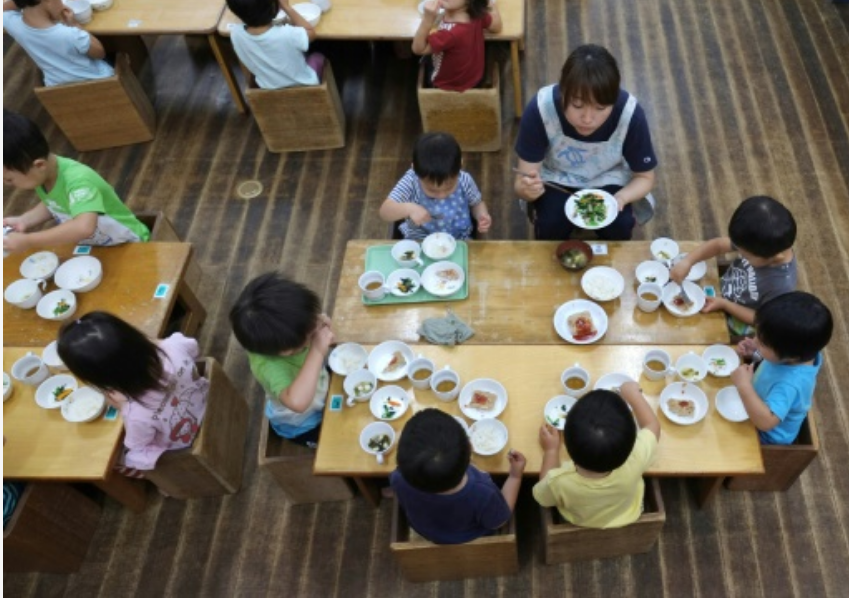日本儿童健康状况全球第一 得益于学校午餐 School lunches keep Japan's kids topping nutrition lists
中国日报网 2019-10-17 13:56

联合国儿童基金会近日发布的报告显示,日本的儿童健康状况位居全球之首,且儿童肥胖发病率极低。分析人士指出,这在很大程度上得益于全日本范围内实施的学校午餐制度。

日本儿童在学校吃午餐。(截图来自共同社)
Japan manages a rare feat for a developed country when it comes to feeding its children -- high scores for nutrition but very low obesity rates. One major key? School lunches.
日本在保障儿童摄入充足营养的同时肥胖发病率极低,这一成就在发达国家中并不多见,其秘诀在于学校午餐。
A landmark report by the UN's children agency UNICEF released Tuesday shows Japan topping the charts for childhood health indicators, with low rates of infant mortality and few underweight children.
联合国儿童基金会于本周二(10月15日)发表的报告显示,日本儿童健康状况全球排名第一,婴儿死亡率低、体重不足人数非常少。
But it also manages the lowest incidence of childhood obesity among the 41 developed countries in the Organization for Economic Cooperation and Development and European Union.
日本也是经济合作与发展组织和欧盟的41个发达国家中,儿童肥胖率最低的国家。
Experts say there are various factors at work, including a health-conscious society and regularly mandated check-ups for children, but a nationwide school lunch program also plays a key role.
专家指出,这一成绩由多种因素促成,包括日本人特别关注健康、定期组织儿童体检,而全日本范围内的学校午餐计划也起到重要作用。
"School lunches with menus that are created by nutritionists are provided to all primary schools and the majority of junior high schools throughout Japan," Mitsuhiko Hara, a pediatrician and professor at Tokyo Kasei Gakuin University, told AFP.
东京家政学院大学教授、儿科医生原光彦(音)告诉法新社说:“日本所有小学和大部分初中都提供由营养师制定菜单的午餐。”
junior high school:初级中学(美国英语)
The lunches are mandatory -- no packed lunches allowed -- and while they are not free for most, they are heavily subsidised.
午餐是学校强制提供的,不允许学生自带饭食。大部分午餐不免费,但有高额补贴。
Each meal is designed to have around 600-700 calories balanced between carbohydrates, meat or fish and vegetables.
每顿午餐含大约600到700卡路里,碳水化合物、肉或鱼、以及蔬菜均衡搭配。
One sample meal served to children in Japan's Gunma gives a flavor: rice with grilled fish and a spinach and sprout dish, served with miso soup with pork, alongside milk and dry prunes.
群马县的学校午餐就是一个范例,包含米饭、烤鱼、菠菜豆芽、猪肉味噌汤、牛奶和梅干。
miso soup:味噌汤

"School lunch is designed to provide nutrition that tends to be lacking in meals at home," education ministry official Mayumi Ueda told AFP. "I think it contributes to the nutritional balance necessary for children."
文部省官员上田真由美(音)告诉法新社说:“学校午餐要能够补充在家吃饭可能摄入不足的营养成分。”
Unlike the cafeteria system operated in some Western countries, Japanese school lunches are usually served in the classroom. Pupils frequently dish out the food to each other and clean up the room afterwards.
与一些西方国家的自助餐厅不同,日本学校的午餐通常在教室里供应。学生们经常互相分发食物,吃完后将教室打扫干净。
There is no choice of meal, and no concessions offered for vegetarians, or anyone with religious restrictions, with members of either group being few and far between in largely homogenous Japan.
午餐没有其他选择,也没有给素食者和信仰宗教儿童的专餐。绝大多数日本人属于同一民族,以上两类儿童都非常少见。
few and far between:稀少的,不多的
The lunches are conceived not only to feed children, but to teach them.
而且,学校午餐不仅是为了让孩子们吃饭,也是为了教育他们。
"There's also a daily broadcast at school to explain the nutritional elements contained in the school lunch of the day, and this is a good way to educate kids," Hara said.
原光彦说:“学校每天会发广播通知,向孩子们解释每日午餐的营养成分。这是教育孩子的一种好办法。”
At primary schools, students use magnets with pictures of food and place them into different categories on a whiteboard, learning to tell their proteins from their carbs.
在小学里,学生们用带有食物图片的磁铁,把食物在白板上分成不同的类别,学习分辨蛋白质和碳水化合物。
"School lunch is positioned as part of education under the law," Ueda said. "It's not just about eating food, but children learn to serve, and clean up on their own."
上田真由美说:“按照日本的法律,学校午餐被定位为教育的一部分。这不仅仅是吃东西的问题,孩子们还学会了服务,学会了自己打扫。”

The Japanese government studies nutrition and eating habits in Japan annually, and uses the results to shape what goes into the school meals, she added.
她还说,政府每年都会研究儿童营养和用餐习惯,并根据调查结果调整学校午餐。
School lunches in Japan date back to as early as 1889, when rice balls and grilled fish were provided for children living in poverty in northern Yamagata prefecture.
日本学校午餐制度可追溯至1889年,当时政府给北部山形县贫困家庭的儿童提供饭团和烤鱼。
But the program was expanded nationwide after World War II ended to address childhood hunger amid serious food shortages.
二战后,针对食物严重短缺导致的儿童饥饿状况,该制度推广到全日本。
And there are other factors at work, Hara acknowledged.
原光彦认为,其他因素也起到了作用。
"Because many Japanese are health-conscious, they try to eat a variety of food, which is good," he said.
他说:“因为很多日本人都有健康意识,人们尽量吃各种各样的食物,这是有益的。”
"And we're taught to eat seasonal food, which also contributes to good health. Japan is one of the rare countries that pay so much attention to food that is associated with specific seasons," he added.
“我们被教导要吃应季食物,这也对健康有益。日本是少数几个如此重视应季食物的国家之一,”他补充道。
The results are clear in the statistics: Japan has one of the world's lowest rates of infant mortality, and the rate of children aged five to 19 who are overweight or obese is 14.42 percent, far lower than most other developed countries.
成果清楚地反映在数据中:日本是婴儿死亡率最低的国家之一,5岁至19岁超重和肥胖儿童比例为14.42%,比大部分发达国家都要低很多。
The US tops the UNICEF ranking, at 41.86 percent, with Italy at 36.87 percent and France at 30.09 percent.
在联合国儿童基金会的排行中,美国超重和肥胖儿童比例最高,为41.86%。意大利为36.87%,法国为30.09%。
Hara said another factor in Japan is regularly mandated childcare health checks. Parents of infants receive reminders from the local government, and children are given health checks at school, including measuring height and weight.
原光彦说,另一个因素是日本强制儿童定期体检。婴儿的父母会收到当地政府的提醒,孩子们会在学校接受健康检查,包括测量身高和体重。
Still, even Japan has not escaped entirely the growing trend toward overweight children and childhood obesity, which in Japan, like elsewhere, tends to affect those from less wealthy families.
然而,即使是日本也未能完全摆脱超重和肥胖儿童日益增多的趋势,这在日本和其他地方一样,往往会影响那些来自不太富裕家庭的儿童。
"Children in poverty are more likely to be overweight because families try to cut costs," Hara said. "As a result, they eat less protein but consume more carbs and sugar, which leads to obesity."
原光彦说,“贫困儿童更有可能超重,因为家庭在努力缩减开支。因此他们吃的蛋白质更少,但却吃了更多的碳水化合物和糖,这会导致肥胖。”
School lunches are all the more important to children in such situations, he said.
他说,在这种情况下,学校午餐对孩子们来说更加重要。
英文来源:法新社
翻译&编辑:yaning

















 英语点津微信
英语点津微信 双语小程序
双语小程序